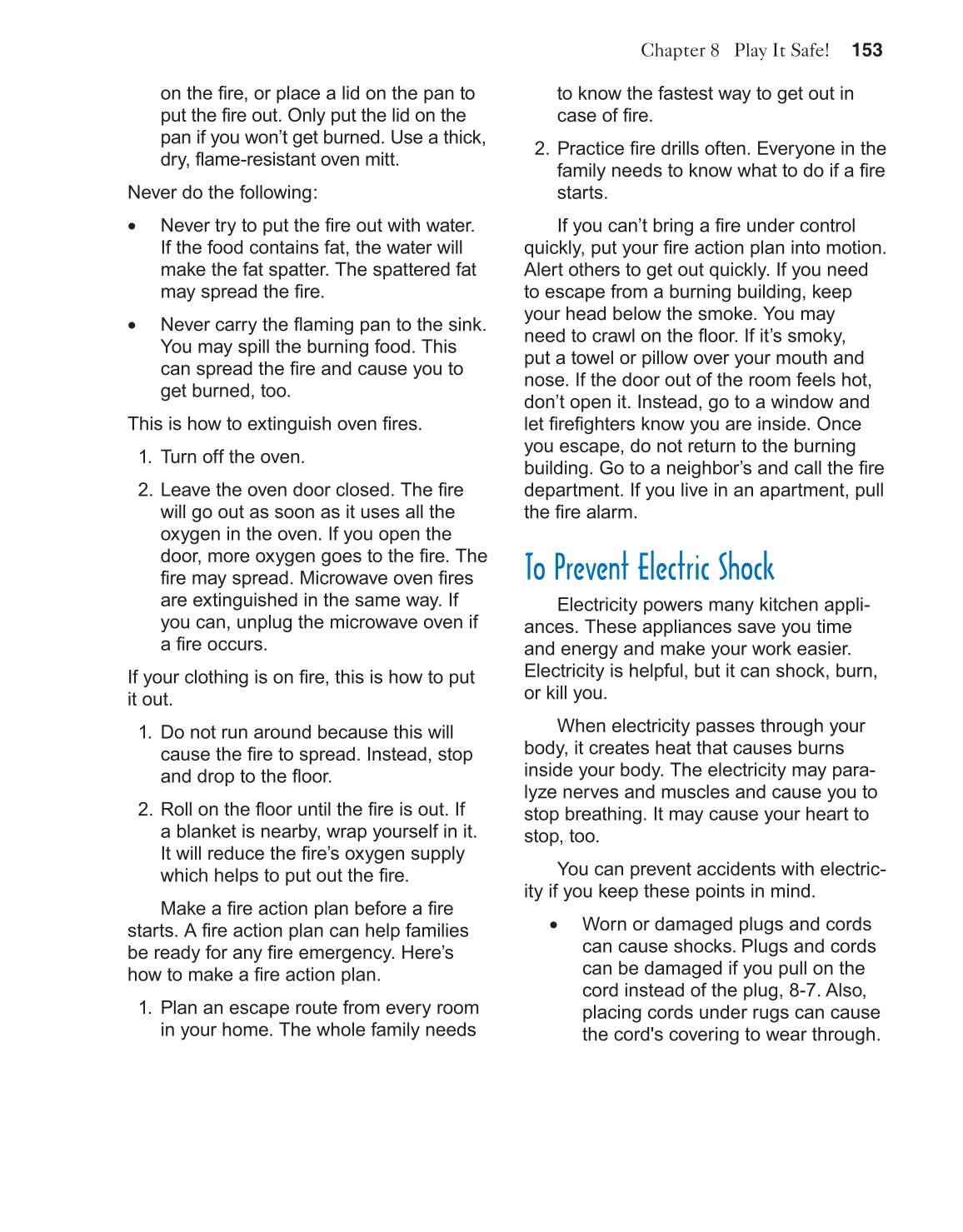Chapter 8 Play It Safe! 153
on the fire, or place a lid on the pan to
put the fire out. Only put the lid on the
pan if you won’t get burned. Use a thick,
dry, flame-resistant oven mitt.
Never do the following:
• Never try to put the fire out with water.
If the food contains fat, the water will
make the fat spatter. The spattered fat
may spread the fire.
• Never carry the flaming pan to the sink.
You may spill the burning food. This
can spread the fire and cause you to
get burned, too.
This is how to extinguish oven fires.
1. Turn off the oven.
2. Leave the oven door closed. The fire
will go out as soon as it uses all the
oxygen in the oven. If you open the
door, more oxygen goes to the fire. The
fire may spread. Microwave oven fires
are extinguished in the same way. If
you can, unplug the microwave oven if
a fire occurs.
If your clothing is on fire, this is how to put
it out.
1. Do not run around because this will
cause the fire to spread. Instead, stop
and drop to the floor.
2. Roll on the floor until the fire is out. If
a blanket is nearby, wrap yourself in it.
It will reduce the fire’s oxygen supply
which helps to put out the fire.
Make a fire action plan before a fire
starts. A fire action plan can help families
be ready for any fire emergency. Here’s
how to make a fire action plan.
1. Plan an escape route from every room
in your home. The whole family needs
to know the fastest way to get out in
case of fire.
2. Practice fire drills often. Everyone in the
family needs to know what to do if a fire
starts.
If you can’t bring a fire under control
quickly, put your fire action plan into motion.
Alert others to get out quickly. If you need
to escape from a burning building, keep
your head below the smoke. You may
need to crawl on the floor. If it’s smoky,
put a towel or pillow over your mouth and
nose. If the door out of the room feels hot,
don’t open it. Instead, go to a window and
let firefighters know you are inside. Once
you escape, do not return to the burning
building. Go to a neighbor’s and call the fire
department. If you live in an apartment, pull
the fire alarm.
To Prevent Electric Shock
Electricity powers many kitchen appli-
ances. These appliances save you time
and energy and make your work easier.
Electricity is helpful, but it can shock, burn,
or kill you.
When electricity passes through your
body, it creates heat that causes burns
inside your body. The electricity may para-
lyze nerves and muscles and cause you to
stop breathing. It may cause your heart to
stop, too.
You can prevent accidents with electric-
ity if you keep these points in mind.
• Worn or damaged plugs and cords
can cause shocks. Plugs and cords
can be damaged if you pull on the
cord instead of the plug, 8-7. Also,
placing cords under rugs can cause
the cord's covering to wear through.
Resource: E.D.I.T.H.=Exit Drills In The Home, Activity B, WB.
Note: Smoke is as deadly as fi re. In fact, many people die from
smoke inhalation rather than burns during fi res. Fire survivors
may suffer serious lung damage due to smoke.
Activity: Have students examine appliance plugs and extension
cords. Which extension cords are heavy duty? How many prongs
does the appliance plug have? How many does the extension
cord have? Are they compatible? What could you do to avoid
having to use extension cords? If you have to use an extension
cord, how can you use it safely?
